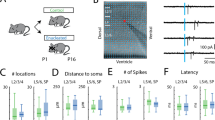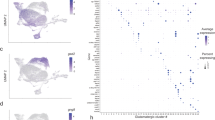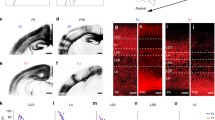Abstract
In several species, the peripheral input from the eyes partly determines the pattern of interconnections between the visual areas of the two cerebral hemispheres through the fibre tract termed the corpus callosum1–9. In the macaque monkey, the neurons projecting through the callosum are largely restricted to area 18 throughout ontogeny, whereas area 17 is characterized by few or no callosal projections10–12. Here, we show that suppressing the peripheral input by prenatal removal of the eyes leads to a marked reduction in the extent of area 17, resulting in a large shift in the position of the histologically identifiable boundary between the two areas. Even so, the boundary continues to separate an area rich with callosal connections (area 18) from one poor in such projections (area 17), indicating there is no effect on the callosal connectivity of area 17. In contrast, in area 18, eye removal results in many more neurons with callosal projections than in normal animals. The results suggest that the factors that determine the parcellation of cortical areas also specify their connectivity.
This is a preview of subscription content, access via your institution
Access options
Subscribe to this journal
Receive 51 print issues and online access
$199.00 per year
only $3.90 per issue
Buy this article
- Purchase on Springer Link
- Instant access to full article PDF
Prices may be subject to local taxes which are calculated during checkout
Similar content being viewed by others
References
Innocenti, G. M. & Frost, D. O. Nature 280, 231–233 (1979).
Innocenti, G. M. & Frost, D. O. Expl Brain Res. 39, 365–375 (1980).
Rhoades, R. W. & Dellacroce, D. D. Brain Res. 202, 189–195 (1980).
Cusick, C. G. & Lund, R. D. J. comp. Neurol. 212, 385–398 (1982).
Rothblat, L. A. & Hayes, L. L. Brain Res. 246, 146–149 (1982).
Rhoades, R. W. & Fish, S. E. Expl Brain Res. 51, 451–462 (1983).
Lund, R. D., Chang, F.-L.F. & Land, P. W. Devl Brain Res. 14, 139–142 (1984).
Grigonis, A. M., Murphy, E. H. & Ostrach, L. H. Soc. Neurosci. Abstr. 10, 53 (1984).
Olavarria, J. & Van Sluyters, R. C. J. comp. Neurol. 230, 249–268 (1984).
Dehay, C., Kennedy, H. & Bullier, J. J. comp. Neurol. 254, 20–33 (1986).
Dehay, C., Kennedy, H., Bullier, J. & Berland, M. Nature 331, 348–350 (1988).
Dehay, C. & Kennedy, H. Behav. Brain Res. 29, 237–244 (1988).
Rakic, P. Science 241, 170–176 (1988).
Kennedy, H., Bullier, J. & Dehay, C. Expl Brain Res. 61, 204–209 (1985).
Kennedy, H. & Dehay, C. Behav. Brain Res. 29, 225–236 (1988).
Kennedy, H., Dehay, C. & Bullier, J. J. comp. Neurol. 247, 398–415 (1986).
Rakic, P. & Williams, R. W. Soc. Neurosci Abstr. 12, 1499 (1986).
Mesulam, M. M. et al. J. Histochem. Cytochem. 28, 1255–1259 (1980).
Wong-Riley, M. Brain Res. 171, 11–28 (1979).
Author information
Authors and Affiliations
Rights and permissions
About this article
Cite this article
Dehay, C., Horsburgh, G., Berland, M. et al. Maturation and connectivity of the visual cortex in monkey is altered by prenatal removal of retinal input. Nature 337, 265–267 (1989). https://doi.org/10.1038/337265a0
Received:
Accepted:
Issue Date:
DOI: https://doi.org/10.1038/337265a0
This article is cited by
-
The retrocalcarine sulcus maps different retinotopic representations in macaques and humans
Brain Structure and Function (2022)
-
Cell migration promotes dynamic cellular interactions to control cerebral cortex morphogenesis
Nature Reviews Neuroscience (2019)
-
Prenatal thalamic waves regulate cortical area size prior to sensory processing
Nature Communications (2017)
-
Modality-specific thalamocortical inputs instruct the identity of postsynaptic L4 neurons
Nature (2014)
-
Growth and folding of the mammalian cerebral cortex: from molecules to malformations
Nature Reviews Neuroscience (2014)
Comments
By submitting a comment you agree to abide by our Terms and Community Guidelines. If you find something abusive or that does not comply with our terms or guidelines please flag it as inappropriate.



